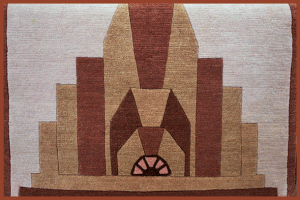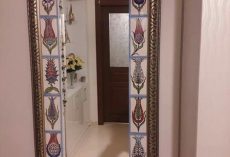Art Deco Rugs
Art deco rugs were introduced to the world at the Paris Exposition of Modern and Decorative Art (Paris Exposition des Arts Decoratifs et Industriels Modernes) in 1925. For that historic world’s fair, the buildings were decorated in art deco rugs and the style took hold.
Art deco designs featured bold geometric shapes, stylized floral patterns and other natural forms, often with juxtapositions of dark and light. Artists from around the world started to design rugs and textiles. Some of the most creative rug designs were created by Jean Michel Frank and Emile Jacques Ruhlmann of France.
These rugs continue to be popular with interior designers today, and you can create your own Art Deco look with these stylish Art Deco rugs. This page showcases some of the best deco rugs available to buy online and at reasonable prices. So if you are looking to create a new style for your home, think about using rugs as decor highlights. Although antique rugs from this era can be quite expensive, you can buy new Art Deco style rugs from $80 to $600. Scroll down to enjoy some easy online shopping.
Art Deco Style
Deco Design Characteristics
The Art Deco Style was influenced by the formalized lines of ancient Egyptian and ancient Aztec art, and it borrowed from neoclassical, modernism, art nouveau, cubism and constructivism.
This time period, just after the First World War, was also known as the Machine Age. For the first time, rugs began to be made my machine, and because they were not expensive like the traditional hand-knotted oriental rugs, they were seen as rugs of the people i.e. stylish designs that the common man could afford. A new market was started and art deco rugs gained increasing popularity in Europe and America.
Not all art deco rugs were machine made, but this was an option, and the world was ready for it.
Art Deco Rug
Deco Rug Design

Art Deco Rugs & Deco Carpets
Designs of the 1920s and 1930s
When it comes to rugs and floor coverings, Art Deco rugs encompass an infinite range of design possibilities. Other applied art movements defined one over-arching theme, while Art Deco embraced influences for all ages and from all over the world. These modernists designs were highly sought after and are still relevant and in demand today.
Rugs and carpets designed in the Art Deco era of the 1920s and 30s represent the best and most beautiful side of industrial design and globalization. By the late 1920s, the rugs and carpets that were produced were colorful and derived their influence from many areas, highly decorative Persian rugs being only one. Designers in rugs, as much as anywhere else where the style was being copied, rated the latest innovations in construction, design and color theory.
The people who designed and wove Art Deco rugs were innovators who paved the way for mid-century and modern designers, abstract artists and many contemporary design movements. At a time when commercial air travel was new and novel, designers, importers and carpet traders provided a vital link between east and west. The cultural diffusion that occurred in the early 20th century is ever-present in Art Deco rugs, even today. The creative atmosphere and historic design conditions of the era resulted in a colorful melting pot that combined influences from all parts of the globe.
Deco Rugs
In Summary
Art Deco rugs and carpets run the breadth of the spectrum in design from stoic masculine rugs with sharp geometric shapes to feminine floral weaves with contrasting colors and pastels. In China, the vibrant jewel-tone carpets manufactured for the explorer and entrepreneur Walter Nichols, are in a league of their own while rugs produced in the same era in England, Europe and Scandinavia were all pieces that led to the designation of the Art Deco or Art Decoratif term in the mid 1960s. British colonial influence in India led to the creation of many phenomenal Art Deco rugs there and they continue to present a combination of modernity and glamour.
In recent years, Art Deco rugs, along with other modernist design, have seen a resurgence. In many places, people are falling back on the reliable, often simplistic, forms to decorate their homes and with good reason: Modernist design fuses form and function into a single beautiful piece that is a work of art in its own right.

